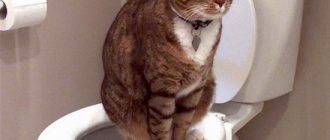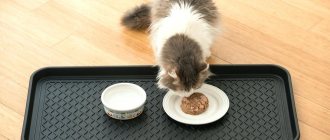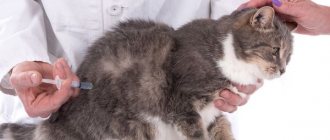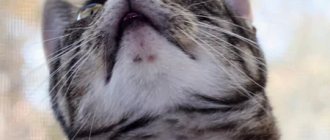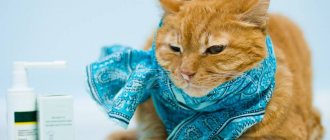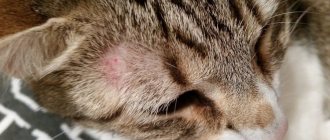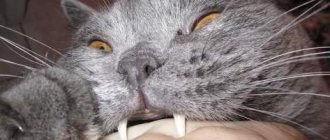Indications for use of Nitroxoline
Cats and cats drink little water. As a result, urine becomes concentrated, which promotes the formation of stones. Stones and sand, in turn, cause irritation of surrounding tissues and lead to inflammatory processes, which can be complicated by secondary infection.
Other causes of infection include various bacteria and viruses that are activated under unfavorable conditions, such as hypothermia or low immunity. During treatment, you can give Nitroxoline to a cat if it is prescribed by a doctor. Proper care and feeding of your pet plays an important role.
What signs indicate that your cat has problems? These include :
- Difficulty urinating. The cat sits on the tray for a long time, while it becomes very nervous, trembles and meows. This unusual behavior is easy for an attentive owner to notice.
- Blood and flakes in urine. These signs are more difficult to notice, so you should pay attention to the cat's behavior during urination.
- The cat's increased attention to its genitals. Cats are clean and groom themselves frequently and thoroughly. With a disease of the genitourinary system, the cat’s attention is focused on the genitals. At the same time, she is nervous and behaves restlessly.
- Urinary incontinence. Sometimes the cat does not have time to reach the tray, and a puddle appears on the floor.
These signs may indicate cystitis or other diseases of the genitourinary system. In these cases, the veterinarian must prescribe appropriate treatment for the pet. The required dosage of Nitroxoline for cats is also determined by the attending physician after diagnosis.
When is the medicine prescribed?
For cats, the drug is used to fight various infections. They can be provoked by urolithiasis. Stones that begin to move contribute to irritation of surrounding tissues and the development of inflammation, which is often accompanied by infection. In addition, infection can be caused by a variety of viruses, which are most active when pets’ immunity is reduced and they are systematically hypothermic. It is effective to use Nitroxoline when animals have problems with urination. The medicine is also prescribed for blood impurities in urine and incontinence of biological fluids. Such conditions are typical for the following diseases:
- inflammation of the bladder and urethra;
- pyelonephritis;
- urolithiasis;
- preparation for surgical interventions on the genitourinary system.
Return to contents
Pharmacological properties
The medicine is available in the form of tablets and suspensions for cats and dogs. The suspension package comes with instructions for using Nitroxoline for cats. Treatment with one drug or another is prescribed by a veterinarian. Self-use of the medicine is not recommended; insufficient or overdose can cause addiction or complications.
The composition of the Stop-cystitis suspension includes two main components:
- nitroxoline – 12.5 mg per ml;
- drotaverine – 6 mg per ml;
- extracts of medicinal herbs and auxiliary components.
The suspension is administered orally, that is, through the mouth. Packaging – 30 ml polymer bottles, with a dispenser and a screw cap.
Nitroxoline is active against infections that cause diseases of the genitourinary system of cats. These are all kinds of bacteria and some fungi.
Drotaverine has a vasodilating effect and relieves spasms. Extracts of medicinal herbs have additional anti-inflammatory and diuretic effects.
For therapeutic purposes, the drug is used 2 times a day. It is given along with food or administered under the root of the tongue using a dispenser. For the purpose of disease prevention - 1 time per day. The dosage depends on the weight of the cat and is prescribed by the doctor.
Compound
The suspension contains a collection of the following herbs:
- nettle;
- common knotweed;
- pusher;
- lingonberry and birch leaves;
- licorice;
- common barberry;
- Canadian goldenrod.
To make it more comfortable for the animal to take the supplement, extracts from the above herbs are obtained using special purified glycerin rather than alcohol. The manufacturer also guarantees that the suspension contains no genetically modified components.
Contraindications
- heart failure;
- liver diseases and liver failure;
- individual intolerance;
- cat pregnancy;
- lactation period.
Other contraindications can only be determined by a doctor. Skipping medication is unacceptable, as this reduces the effectiveness of treatment.
No side effects of the suspension have been established. In case of allergic reactions, the drug is discontinued.
Nitroxoline tablets are prescribed by a veterinarian strictly individually, if there are indications for this.
Nitroxoline is active against infections that cause diseases of the genitourinary system of cats. These are all kinds of bacteria and some fungi.
Stop cystitis tablets for dogs and cats
COMPOSITION AND FORM OF RELEASE
Stop-cystitis is a complex drug for the treatment and prevention of urological diseases in dogs and cats in the form of tablets for oral use. 1 tablet contains: 25 mg of nitroxoline (12.5 mg in a tablet for cats), 30 mg of drotaverine hydrochloride (10 mg in a tablet for cats), 10 mg of juniper fruit extract, 10 mg of knotweed herb extract, 10 mg of extract nettle leaves, 10 mg of licorice root extract, 10 mg of lingonberry leaf extract, 10 mg of birch leaf extract, as well as auxiliary components. In appearance, the drug is a tablet weighing 200 mg for oral use. Packaged in 15 and 20 tablets in polymer jars, packed in cardboard boxes.
The drug Stop-cystitis tablets has a complex uroseptic, anti-inflammatory, antimicrobial, antispasmodic and diuretic effect, promotes the removal of toxic products and urinary stones from the body. Nitroxoline is an antimicrobial agent from the group of 8-hydroxyquinolines with a wide spectrum of action against pathogens of bacterial infections: Staphylococcus spp., Streptococcus spp., Enterococcus faecalis, Corynebacterium spp., Bacillus spp., Escherichia spp., Proteus spp., Klebsiella spp., Salmonella spp., Shigella spp., Enterobacter spp. Ureaplasma urealyticum. In addition, nitroxoline is active against some protozoa and fungi (genus Candida); it selectively inhibits the synthesis of microbial DNA and forms complexes with metal-containing enzymes of the microbial cell. Drotaverine hydrochloride has antispasmodic, myotropic, vasodilating and hypotensive effects, reduces the flow of calcium ions into smooth muscle cells, reduces the tone of smooth muscles of internal organs, and reduces pain during urination. The medicinal plants included in the preparation contain a number of biologically active compounds - flavonoids, saponins, essential oils, tannins, vitamins and minerals, which have an overall positive effect on the processes of restoring the functions of the excretory and reproductive systems of animals. Natural plant extracts have pronounced diuretic, anti-inflammatory and uroseptic properties, reduce pain when urinating, and promote the passage of urinary stones and calculi. When administered orally, the components of the drug are well absorbed from the gastrointestinal tract, nitroxoline is excreted unchanged by the kidneys, creating a high concentration in the urine. Stop-cystitis tablets, in terms of the degree of impact on the body of warm-blooded animals, are classified as low-hazard substances and in recommended doses do not have a hepatotoxic or sensitizing effect.
Prescribed to dogs and cats for the prevention and treatment of inflammatory diseases of the genitourinary system, including cystitis, urethritis, pyelonephritis and urolithiasis. For preventive purposes, it is prescribed during diagnostic studies (cytoscopy, catheterization) and during surgical interventions on the kidneys and urinary tract.
DOSES AND METHOD OF APPLICATION
Stop-cystitis tablets are administered to dogs and cats individually orally with food or forcefully into the oral cavity on the root of the tongue in the following dose:
Animal body weight, kg
Number of tablets per animal
Prescribed to dogs and cats for the prevention and treatment of inflammatory diseases of the genitourinary system, including cystitis, urethritis, pyelonephritis and urolithiasis. For preventive purposes, it is prescribed during diagnostic studies (cytoscopy, catheterization) and during surgical interventions on the kidneys and urinary tract.
How do Stop Cystitis tablets work?
The main active component of the drug is the antibiotic Nitroxoline. This is why tablets are not suitable for long-term prevention. Nitroxoline is active against sensitive gram-positive and gram-negative microorganisms that usually cause urinary tract infections.
The second active component of the tablets, drotaverine hydrochloride, is an antispasmodic and quickly eliminates painful symptoms when urinating. Stop Cystitis tablets have good penetration into urine. After oral administration, the peak concentration of active components in the blood plasma is observed after one hour, and the maximum concentration in the urine after 4-5 hours. Nitroxoline also enters the gastrointestinal tract in sufficiently large quantities, so more than 50% of the drug is excreted in feces, and only 30% in urine.
Stop cystitis for cats
In traditional veterinary medicine, cats of various ages and breeds are often diagnosed with urological diseases of various pathogenesis and etiology. Disturbances in the functioning of the organs of the genitourinary system can arise for a variety of reasons, under the influence of unfavorable exo- and endogenous factors. For the treatment of inflammatory and infectious diseases in representatives of the cat family, the pharmacological industry has developed many drugs, and “Stop-cystitis” can be called the most effective remedy for the treatment of urological diseases.
We recommend reading: Dog produces green afterbirth
The veterinary medicinal product was highly appreciated by veterinary specialists, with many positive reviews from happy owners of cats who were diagnosed with pathologies and diseases of the urinary system.
Description of the drug
Stop-cystitis for cats is a domestically produced complex medicinal product used in veterinary practice for the treatment and prevention of acute and chronic diseases of the urinary system of an inflammatory, infectious and bacterial nature. The drug is also used after various diagnostic procedures (cystoscopy, catheterization), abdominal surgery on the kidneys, bladder, which in turn prevents infection and re-formation of urinary stones.
Available in the form of a suspension for oral use in 30 ml polyethylene bottles with a screw cap, as well as in the form of tablets for oral administration. The oral suspension has a dark brown color and a pleasant specific aroma. It is allowed for the drug to stratify and form a sediment at the bottom of the bottle, which completely dissolves when shaken. In the box, in addition to the veterinary drug itself, there is a dispenser syringe that makes it easier to administer the medicine or a measuring cup. There must be instructions for the use of a pharmacological agent.
The main active ingredients of the drug are nitroxoline (12.5 mg), drotaverine hydrochloride (10 mg). 1 ml of medicine contains 0.5 mg of dry extract of the following medicinal plants:
- knotweed;
- nettle;
- common barberry;
- licorice root;
- birch leaves;
- lingonberry leaves;
- horsetail;
- Canadian goldenrod;
- club-shaped swimmer.
Healing plants have a unique biochemical composition that has a beneficial effect on the genitourinary system and the animal body as a whole. They contain flavonoids, pectins, tannins, organic, essential amino acids, mineral compounds, vitamins, essential oils, saponins in sufficient concentration.
Stop-cystitis contains auxiliary components - Carboxymethylcellulose, starch, polyvinylpyrrolidone, which enhance the effect of the main active substances.
The veterinary drug is absolutely non-toxic for animals. If the specified dosage is observed, no side effects are noted. Nitroxoline does not accumulate in the body of warm-blooded animals, is excreted unchanged in the urine, and does not have a hepatotoxic or sensitizing effect in therapeutic doses.
Benefits of Stop cystitis for cats:
- complex action;
- no contraindications;
- no side effects;
- can be used for small kittens, pregnant and lactating cats.
Important! Treatment of Stop-cystitis in pregnant women. nursing cats are carried out only on the recommendation and under the strict supervision of the treating veterinarian.
Before using the veterinary drug, carefully read the leaflet and instructions for use. Do not exceed the indicated dosage to avoid causing side effects. In addition, despite the low toxicity and safety of this drug, before starting treatment for your furry pet, be sure to consult with your veterinarian.
Stop Cystitis for cats should be stored in a cool place, protected from moisture and direct sunlight, away from food and feed at a temperature of 0 to 25 degrees Celsius in a closed bottle.
Pharmacological properties
Stop cystitis for cats is prescribed to normalize the functioning of the excretory and reproductive system. The veterinary drug is prescribed to furry patients for the treatment of acute and chronic urological ailments of various etiologies:
Veterinarians also use the drug for preventive purposes, to prevent the development of urolithiasis in cats, as well as during catheterization and cystoscopy to prevent infection of the animal with dangerous viruses and bacteria.
Stop cystitis for animals has a pronounced antispasmodic, diuretic, antimicrobial, anti-inflammatory, and antiseptic effect.
The active components of the drug are well absorbed in the gastrointestinal tract, relieve spasm of the smooth muscles of the genitourinary tract, relieve pain during urination, and promote the rapid removal of urethrates, calculi, urinary stones from the kidneys and bladder.
The main active component of the drug (nitroxoline) is effective against most types of gram-positive, gram-negative bacteria, viruses, such as: streptostaphylococcus, E. coli, ureplasma, Klebsiella, as well as some classes of protozoan parasitic fungi of the genus Candida. The action of nitroxoline is aimed at suppressing the synthesis of bacterial DNA of pathogenic agents.
Healing plants normalize impaired functions of the genitourinary tract, have a general strengthening effect, improve the general physiological condition of animals, promote faster recovery, and have a mild diuretic and analgesic effect. Alkaloids, flavonoids, pectins, tannins of medicinal plants reduce crystallization processes, which in turn reduces the formation of stones in the kidneys and bladder.
Stop cystitis for cats for treatment or preventive purposes should be prescribed by a veterinary medicine specialist on an individual basis. The frequency of administration and the duration of the treatment course depend on the age, general condition of sick animals, stage, and form of the diagnosed disease.
Important! In order not to harm your beloved cat if there are obvious signs of a urological disease, you should not self-medicate. Treatment methods are prescribed by a veterinarian after a comprehensive examination.
Stop-cystitis is given to cats by forced infusion into the oral cavity using a dispenser syringe, or the suspension is mixed into food or a favorite treat. Given the resourcefulness of cats, it is best to crush the tablet into powder and mix it with raw minced meat. You can also place the medicine on the base of your tongue with your mouth wide open. Hold your pet's mouth for a few minutes until the swallowing reflex appears.
Using a dispenser syringe, calm your pet and secure it well in your arms. Fill the syringe with the required dose of medicine, open the cat’s mouth and carefully inject the medicine into the cheek. Hold the cat's head up for a few minutes and stroke it under the neck to stimulate the swallowing reflex. After the procedure, be sure to praise the cat and reward it with a treat.
Stop cystitis for cats goes well with other pharmacological agents, mineral and vitamin supplements, medicinal industrial feeds, and multivitamins. It is very important to adhere to the dosage indicated in the instructions.
The dosage of the veterinary drug depends on the body weight of your beloved cat. When treating cats weighing up to 5 kg, the single dose is 2 ml twice a day (morning and evening). For cats weighing more than five kilograms – 2.5-3 ml.
If Stop Cystitis in tablets is used for treatment: cats weighing up to 4-5 kg are given one tablet at a time, cats weighing more than 4.5-5 kg are given two tablets.
For preventive purposes, the drug is given to cats once a day for five to eight days. During treatment - twice a day.
During treatment and preventive therapy, adhere to the rules of asepsis and use sterile instruments. Before giving your cat medicine and after the procedure, wash your hands well with soap and water.
Instructions for use
Tablets for cats
The medicine for cystitis and other problems is administered orally 2 times a day. The owner will need to give the pet 1-2 tablets, the exact dosage is directly related to the cat’s body weight. If the medication is used for preventive purposes, it should be given to the cat once a day for a week. If we are talking about the treatment of diseases of the urinary system, then the course is mainly 2 weeks with the use of tablets twice a day. Before giving your pet a pharmaceutical, it is important to wash your hands well with soap and treat them with an antiseptic solution. You can use crushed tablets that are added to food. It is also permissible to use the whole medicine, which must be placed on the base of the cat’s tongue, while opening its mouth well. After this, veterinarians recommend giving the animal a favorite treat.
How to use the suspension?
If we talk about this dosage form, then it will need to be forcibly poured into the cat’s mouth using a dispenser syringe, which is included with the suspension. It is also acceptable to add the medication to your pet’s food. If the cat weighs less than 5 kilograms, the dose will be 2 ml of suspension 2 times a day. If the animal’s body weight is more than 5 kg, 3 milliliters of medicine is used. Before using the medication, shake the bottle. Veterinarians also recommend petting the cat and holding it in your arms.
It is important to ensure that the animal swallows the medicine.
Then you will need to draw the required amount of pharmaceutical product into the syringe dispenser and open the animal’s mouth with pre-washed hands. Next, the syringe must be carefully inserted into the oral cavity and gradually squeeze out the suspension. The animal's head will need to be held elevated for 2-3 minutes. Next, you need to stroke the cat's neck to stimulate the swallowing reflex.
Veterinarians recommend giving the animal the described medication simultaneously with vitamin and mineral supplements, as well as ready-made complementary foods that have medicinal properties.
Contraindications
As already noted, if the indicated dosage and recommendations of the treating veterinarian are strictly followed, no side effects are observed in cats after taking the veterinary drug. In case of individual intolerance, hypersensitivity to the active components of the drug, allergic reactions may occur, and salivation may be profuse. In this case, contact your veterinarian, stop taking the drug, and give the cat an antihistamine.
We recommend reading: Yellow Cat Vomits in the Morning
Stop-cystitis is not recommended for treatment and prevention in animals with chronic heart or kidney failure.
Benefits of Stop cystitis for cats:
Nitroxoline For Cats
A 4-year-old cat with chronic attacks of coughing and vomiting. In this regard, we decided to make a diagnosis. Apart from this, the cat does not show any signs of illness. We fed the last code with drying hils for a sensitive stomach. Weight 4.3 kg. We live in Moscow. They made a diagnosis, it turned out that the kidneys and gallbladder were enlarged, and a blood and urine test was also done. They said nephritis or cholecystitis was possible and prescribed treatment with a bunch of homeopathic drugs and included catharine and nitroxoline, healthy kidneys, protection against infections, cat Erwin, Traumatin, Liv52. However, the doctor said that the urine test was strange, possibly incorrect, given the cat's healthy condition and good blood work. Like, she should be dying with this kind of urine already. However, the treatment was prescribed based on the test results. Is it really impossible to say exactly what kind of disease and how to treat it based on the tests? I know that nitroxoline is quite toxic, should I feed it to a cat, maybe there is something more expensive and easier? Maybe someone understands this and can tell me what to do, either retest the urine, or start the prescribed treatment.
The following ultrasound, urine and blood tests: Ultrasound: Bladder: moderate. filling, visual in the lumen. shadow characteristic of mucus. Wall of the bladder 2 million Liver: hypoech, clearly defined boundaries. The gallbladder is enlarged and full. homogeneous liquid, hypoecho. Kidneys approx. 31.5 to 22.5, echogenicity of the cortical layer is increased (7.8 mm), brain. anechoic layer (10mm) left. 30.5 to 23.8 the cortex and medulla are hyperechoic. The spleen (7.3 mm) is hypoechoic, homogeneous, the boundaries are pronounced, and no free fluid was found in the abdominal cavity.
Urine: (n is the norm) Color straw yellow Transparency incomplete Density 1.038 (n 1.001-1.07) Protein 0.3 (n - no) Glucose n Ketones no Urobilinogen n Bilirubin n Blood no Squamous epithelium 0-2 (n 0-2 in field of view) Transitional epithelium 1-3 single in field of vision. Renal epithelium no Atypical epithelium no Erythrocytes single (n 0-3) Leukocytes 2-5 (n 0-3 in p.s.) Cylinders none Streptobacilli bacteria +++, cocci + (urine collection was from the usual tray into a jar, possibly from trace of old urine) Triple phosphate crystals+++ (n-no) Mucus ++
Blood: Slightly increased Red blood cells 12.9 (n 5-10) Hemoglobin 161 (n 80 - 150) Hematocrit 51.5 (n 24-45) Eosinophils 15 (2-12) Decreased: Average hemoglobin content. in erythrocytes 12.5 (n.13-17) Lymphocytes 11 (n.20-55) Everything else is normal, laboratory technician’s note - slight agglutination of erythrocytes - what does this mean. In biochemistry, increased Cholesterol 7.51 (n 1.8-5.83) aspartaminotransferase 54 (n 11-44) Albumin 38 (25-37) Albumin to globulin ratio 1 (0.5-0.9) Everything else is normal.
Thank you in advance.
| to come back to the beginning |
It is extremely rare that an accurate diagnosis can be made based on blood and urine tests. | ||
| Some of the symptoms don’t look like acute cystitis. usually nitroxoline is prescribed for it _________________ Non refert quam multos, sed quam bonos habeas / It’s not how many books you have that matter, but how good they are (Seneca) |
| Nitroxoline is absolutely useless, the whole point is that it “works” only after the first dose, and then that’s it, bacteria develop resistance to it. and literally within a few hours, and the course of treatment with this drug is 7-10 days. Although I don't argue, most human and veterinary doctors continue to prescribe it. Only here's why. Currently, the drug MONURAL is used for bacterial cystitis in humans. There is probably no experience of using it on animals. |
| There is nothing terrifying in a urine test, but this does not mean that it is good. It is unknown whether the bacteria are native or from the pot (you can’t tell from the leukocytes that it is from the bladder). High density; obviously, an alkaline reaction and, as a result, tripelphosphates. The analyzes must be shown in full. What seems unimportant to you is often important. Nitroxoline is not a very good option (in my opinion) - especially since there are problems with the liver. The rest of the prescriptions are quite normal. We need to think about an antimicrobial drug, it is very necessary. Does the cat drink little? An increase in Hb and red blood cells occurs in cases of kidney disease, bronchial disease of an allergic nature, and dehydration - this is the simplest and most likely in this case. Agglutination can also be physiological (a certain percentage) . |
| I agree with Sveta. regarding a possible reaction to unsuitable food. I also don’t see anything wrong with a urine test, especially urine from an “unprepared” tray. I would retake the urine test in Zhavnis’s laboratory (tel. 677-07-35) and for now I would not use any antimicrobial drugs, Zhavnis himself is now on vacation, Svetlana Zotova works in the lab (closed on Sunday, Monday), you can safely take the urine to her . Wash the cat before peeing (wipe the intimate parts with a damp cotton swab), rinse the tray well with a cloth or sponge (without using any “Fairies”), rinse thoroughly with running water, scald with boiling water. Prepare the urine jar well too (like a tray). Bring your urine for analysis immediately (or put it in the refrigerator while you are going to the lab) - otherwise you will end up with unknown “bacteria” and salts from where (which could have settled in the tray after several peees). Ask Svetlana to pay special attention to the bacteria, to indicate their quantity and her “assessment” of this quantity.
|
Cat with chronic renal failure
Hello! The cat was diagnosed with chronic renal failure. About the cat: 1. Outbred, 12.5 years old 2. No vaccinations; sterilized at 9 years old (there was inflammation, the uterus was cut out) 3. Until recently, she ate: chicken (+ broth), meat, bread, water, milk, grass.
The problems with my kidneys started 1 year and 2 months ago. I stopped drinking and eating, I was constipated. We took him to the doctor, they ordered an ultrasound, and the ultrasound revealed that one kidney was inflamed, and the kidneys themselves were reduced in size. Nephrofit was prescribed for 20 days, 30 ml. After treatment, all symptoms disappeared. Six months later, the Nephrofit course was repeated.
Now, at the end of August, when we started giving her Nephrofit again (we were prescribed it once every six months), the cat started having complications again: she couldn’t urinate, she was straining, there was blood in the urine. They took a urine test and found protein in the urine, and the kidneys were prolapsed again. They prescribed an antibiotic, Nephrofit. The symptoms went away.
After some time, the cat began to drink more. A week ago we gave her a bath (she was already very dirty
) and her condition sharply worsened (appetite worsened, she began to sleep more and more, drink a lot, constipation). We went to the doctor and they sent us for an ultrasound. Based on the results of the ultrasound, a diagnosis of CNP was made (they said that the left kidney was destroyed by 60 - 70%, the right one was affected only slightly (when examined by ultrasound, at first the right kidney was completely overlooked (it looked good), only after examining the left one they took a closer look at it)).
Yesterday I was prescribed: Nephrofit daily, Canephron (1/4 tablet per day), Nitroxoline (1/4 tablet 2 times a day), Festal, switching to Purina NF dietary food.
Yesterday the cat attacked the food greedily and ate it with gusto. Then we gave her Festal, then Canephron, and she got it in with a little difficulty (well, within the normal limits in such cases). Then it was Nitroxoline’s turn, the cat categorically refused to swallow the tablet, they mixed it into the food - she wouldn’t eat it, diluted it in a small amount of water and tried to administer it with a syringe - she began to spit out the water, she vomited (and all the food too, unfortunately, she was left completely hungry). Then we somehow gave her a little drink of this diluted Nitroxoline. Then in the evening the cat ate some more food.
Today she is not eating anything, I only drank a little chicken broth. Today we were unable to give her either Festal or Nitroxoline (we have now replaced it with injections of Enrobioflox 0.5 ml per day for 6 days), Canephron diluted in a drop of water was given with difficulty. The cat is lethargic (although yesterday it was not so lethargic, compared to the day before yesterday, for example, in my opinion it was even a little more active (before taking Nitroxoline)), does not eat. He often wants water, so we feed it with Nephrofit.
The cat has been peeing all this time (this morning too), the smell of urine has been ammonia-like for the last few days.
Please give me advice: 1. Are the medications prescribed normal? 2. Why might the cat now not want to eat (could this be a reaction to Nitroxoline? After all, she ate the food yesterday.
Or could complications with the kidneys appear so quickly? )? 3. Do droppers and injections with saline help? Is it necessary to put it on? (the doctor says that this is ineffective, I also read that this is an additional burden on the kidneys)
“Stop cystitis” for cats: price, instructions and reviews
The health of a pet is the most important thing for the owner. And it is very important to observe the cat every day, noticing the slightest deviations. In particular, if your pet begins to react painfully to touches on its tight, as if inflated tummy, often runs to the tray and gently turns over while resting, clearly demonstrating discomfort, then it’s time to run to the doctor. The drug “Stop Cystitis” for cats will help relieve pain, but this will not eliminate the need to conduct a full examination and treatment.
Real reviews about Stop Cystitis tablets and suspension
Polina, 24 years old:
“One day, my beloved cat Mushka began to scream a lot before going to the toilet in a small way. I immediately took the cat to the vet. The doctor prescribed us an antibiotic and a Stop Cystitis suspension. After a week, the cat’s pain completely stopped. And recently she again started meowing a lot when going to the toilet. I decided to give her Stop Cystitis without an antibiotic. No effect! So the suspension is not suitable for treatment at all.”
Zinaida, 28 years old:
“I bought Stop Cystitis tablets for cats as prescribed by the veterinarian. The doctor recommended prophylaxis before cat sterilization surgery. I was worried for a long time about giving my pets antibiotics (they never had any problems with the urinary system). But on the other hand, no complications arose after the sterilization operation. I think that this is still a big merit of the tablets.”
Alena, 39 years old:
“The child begged for a kitten - a British one. After the purchase, I learned that this is one of the most painful breeds. I vaccinated against literally everything, I regularly give her tablets against worms. A couple of times a year I also buy Stop Cystitis for prevention. The drug is quite expensive, but does not cause side effects in cats. There have been no problems for three years now.”
Every second family has furry pets. Cats need good care, healthy nutrition and human love. Unfortunately, they often experience problems with the genitourinary system. In this case, stop cystitis for cats will be a real salvation from the disease. The drug is available in tablets and suspension form. It can relieve severe pain, has an anti-inflammatory effect and actively kills microbes in the body
Cystitis. Terrible disease
It occurs very often. And this, as a rule, is facilitated by the conditions of detention. The apartments are very hot, but there are drafts on the window sills, where purrs like to rest, as well as on the floor (due to the open balcony).
The occurrence of the disease is caused by poor nutrition, inadequate vaccination schedule, and decreased immunity due to the use of antibiotics or other drugs. It can manifest itself in acute and chronic forms. The latter is difficult to diagnose, greatly exhausts the body, undermines the immune system and shortens the animal’s life expectancy.
The drug “Stop Cystitis” for cats is a powerful tool that allows you to relieve the symptoms of the disease and return your pet to normal life. But if you calm down on this, after a while the disease will return and be much more severe.
Dosage form
The drug “Stop Cystitis” for cats is most often prescribed in drops. This makes it easier to feed it to your pet; you can dilute it with water or add it to a treat, for example, minced meat. The suspension is packaged in bottles of 30, 50, 100 and 150 ml with caps. Each of them comes with a dispenser syringe. The suspension can range in color from light brown to dark green. It must be shaken before use, as the liquid may separate. Each bottle is labeled with its name, expiration date, release date, and batch number.
Another option is the drug “Stop Cystitis” for cats in tablets. It has an identical composition. It is necessary to place the entire tablet directly on the root of the tongue or first crush it and dilute it with water.
Composition of the drug
“Stop Cystitis” for cats is a combined drug, which ensures its effectiveness. The product contains nitroxoline, which is active against a variety of bacteria and some fungi - pathogens of diseases of the genitourinary system. To relax smooth muscles and relieve pain, the composition contains drotaverine hydrochloride.
The second part of the composition is the active components of medicinal plants, which have antimicrobial, anti-inflammatory, diuretic and antispasmodic properties. This is an extract of licorice herb, lingonberry leaves, juniper fruits, nettle leaves and adonis herb.
Composition and release form
The medicine is produced in the form of tablets and suspension. The two release forms contain 2 identical active ingredients: drotaverine and nitroxoline. Additional components are extracts of lingonberry leaves and knotweed grass, licorice root extract and juniper fruits. Tablets and suspension are taken orally. “Nitroxoline” is active in the fight against various infections that provoke the development of diseases of the urinary system, for example, various fungi and bacteria.
Properties of the drug
Today, most of us have access to the Internet. Accordingly, the information of interest can be obtained immediately. Having noticed similar symptoms, the owner can independently buy the drug “Stop Cystitis” for cats. The instructions for use contain all the necessary information; there will be no problems with calculating the dosage, and the pet’s condition will improve significantly.
As a result, you will be able to relieve the symptoms, but not find the cause. It is imperative to undergo tests before prescribing the drug. The source of the problem may lie in metabolic disorders, problems with the gastrointestinal tract, nephritis, and even severe stress.
“Stop Cystitis” has excellent preventive properties. If you have successfully dealt with the disease and obtained a lasting result, then you need to follow the doctor’s recommendations for keeping and feeding your pet, and periodically give it this drug. Its main advantage is the presence of active components of medicinal plants. This allows you to restore kidney function, remove toxins and small stones. Due to its low toxicity, the drug can be used even for kittens and pregnant cats. And since its price is low, anyone who has encountered urological problems with their pet can constantly keep the “Stop Cystitis” drug for cats at home. The instructions for use allow its use for preventive purposes for 5 days at an interval of 1-2 months.
Indications for use
In veterinary practice today, the drug “Stop Cystitis” for cats is widely used. Reviews about it are very good; it quickly relieves even the most severe symptoms. The medication is necessary in preparation for operations to remove bladder stones. You cannot do without it in the postoperative period to prevent the development of infection. This remedy is also effectively used to treat acute and chronic infectious diseases of the urinary tract. If the pet has a predisposition to them, then the owner is simply obliged to purchase the drug “Stop Cystitis” for cats. Reviews confirm that timely administration of medication helps prevent urolithiasis and eliminate the need for surgical intervention.
The drug is prescribed individually, it all depends on the size and age of the pet, its condition. The general regimen involves taking one tablet once a day for prevention and twice a day for treatment. The duration of use is 7 days, unless otherwise directed by the doctor. If the pet's weight is more than 5 kg, the dose may be increased. After completing the course, you should consult with a veterinarian, who will evaluate the effectiveness of the therapy and suggest additional measures, if necessary, to achieve full recovery.
Almost the only drug that has a mild effect, pleasant taste and herbal origin is “Stop Cystitis” for cats. The price is affordable for most of us (about 150 rubles for a 30 ml bottle, enough for about two weeks of prevention or a week of treatment).
Instructions for use Stop Cystitis
It is not recommended to give Stop Cystitis tablets to animals:
- with impaired renal function;
- with anuria;
- with severe liver diseases;
- during pregnancy and lactation.
There are no side effects (subject to the instructions for the drug and the recommendations of the veterinarian). In case of an overdose, nausea, vomiting, and disruption of normal urination may develop.
First of all, you need to remember that the suspension is a feed additive, not a medicine. This is confirmed by the instructions for Stop Cystitis for Cats. Due to the fact that the supplement contains only completely natural ingredients, you can give it to your cat for two weeks. The daily dosage is calculated based on the formula 4 ml. suspensions per 5 kg weight.
Attention! The instructions indicate that the animal should not be given more than 2 ml at a time. additives. Accordingly, it is necessary to calculate the daily dose and divide it into several feedings.
Compared to tablets that contain synthetic components, the suspension is less aggressive. A food additive will not be able to cope with an existing infection, but will help the cat’s body resist the development of new problems with the urinary system. The main advantage of the Stop Cystitis feed additive is that it can be given even to cats with liver and kidney diseases.
Even when using an all-natural suspension, it is important to avoid overdosing. Medicinal herbs, like any other medicine, have side effects. Constantly administering an increased dose of the suspension to an animal can ultimately provoke a deterioration in the condition of the urinary system. For example, instead of normalizing urination, the cat will begin to suffer from polyuria.
Advice! It is necessary to give the animal a strictly calculated dose. The rule “more is not always better” is fundamental to herbal medicine. If it is not possible to give the suspension several times during the day, it is better to refuse prophylaxis altogether than to give the daily dose in one dose.

